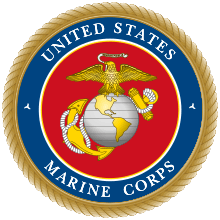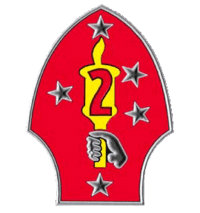2nd Light Armored Reconnaissance Battalion
2nd Light Armored Reconnaissance Battalion is a fast and mobilized armored terrestrial reconnaissance battalion of the United States Marine Corps. Their primary weapon system is the 8-wheeled LAV-25 and they fall under the command of the 2nd Marine Division and II Marine Expeditionary Force. The unit is based out of the Marine Corps Base Camp Lejeune, North Carolina. The current mission statement of the battalion is: To perform combined arms reconnaissance and security missions in support of the Ground Combat Element (GCE) of a Marine Air-Ground Task Force (MAGTF). Its mission is to conduct reconnaissance, security and economy of force operations, and, within its capabilities, limited offensive or defensive operations that exploit the unit's mobility and firepower.
| 2nd Light Armored Reconnaissance Battalion | |
|---|---|
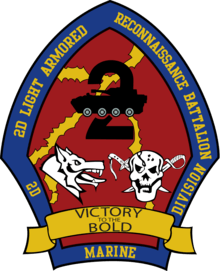 2nd LAR's emblem | |
| Active | 1985 – present |
| Country | |
| Branch | |
| Type | Light armored reconnaissance battalion |
| Part of | 2nd Marine Division II Marine Expeditionary Force |
| Garrison/HQ | Marine Corps Base Camp Lejeune |
| Nickname(s) | "Destroyers" |
| Mascot(s) | American Bulldog |
| Engagements | Operation Just Cause Operation Desert Storm Operation Provide Comfort Operation Restore Hope Operation Restore Democracy Operation Joint Guardian Operation Avid Response Operation Unified Response War on Terror
|
| Commanders | |
| Current commander | LtCol Scott Cuomo |
| Command Sergeant Major | Sgt Maj Paris E. Mintz |
The LAR battalion may function as an independent maneuver element or as an element of a larger unit such as a regimental combat team, or its subordinate companies may support other tactical units in the GCE.
Subordinate units
 H&S Company (Striker)
H&S Company (Striker) Alpha Company (Apache)
Alpha Company (Apache) Bravo Company (Black Knights)
Bravo Company (Black Knights) Charlie Company (Gunfighters)
Charlie Company (Gunfighters) Delta Company (Outlaws)
Delta Company (Outlaws)
Organization
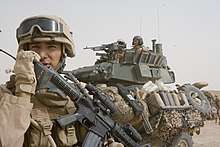
The LAR battalion's organization allows it to conduct the full range of command functions. The LAV's mobility is maximized when the battalion is assigned independent missions for either the GCE or any of its subelements. The LAR battalion may also be assigned missions that require placing it or its subordinate companies in support of other MAGTF formations. The LAR battalion and each of its companies have an organic maintenance and recovery capability as well as sufficient communications equipment for sustained independent battlefield operations.
The 2d, LAR Battalion is assigned to the 2nd Marine Division and possess 3 line companies along with a headquarters and service company.
Light Armored Vehicle Mission Role Variants
The LAR battalion is equipped with six mission role variants (MRVs):
- LAV-25 (light armored vehicle-25 millimeter).
- LAV-AT (light armored vehicle-antitank).
- LAV-M (light armored vehicle-mortar).
- LAV-C2 (light armored vehicle-command and control).
- LAV-L (light armored vehicle-logistics).
- LAV-R (light armored vehicle-recovery).
- Light Armored Reconnaissance Scouts:
Light Armored Reconnaissance Scouts
Marines who have the military occupational specialty (MOS) 0311, rifleman are assigned to the LAR battalion as scouts. The scouts receive their scout training from the LAR battalion. The LAR scouts are not employed the same way as infantry or mechanized infantry. Each LAV-25 carries three scouts, who are trained and organized for employment in support of the LAV-25. The LAR scouts should be thought of as an integral part of the vehicle's employment capabilities. The vehicle/scout team is a complete system, with the vehicle and its scouts each dependent on the other for security, mobility, and firepower.
Troop Density
The LAV-25 carries three LAV crewmen and four personnel (typically three scouts and either a corpsman, engineer, or mechanic) per vehicle. The LAR battalion table of organization (T/O)provides for 216 scouts. Operations requiring large numbers of infantry favor employing mechanized infantry units due to their higher troop density. This limitation can be offset by planning for reinforcements of LAR by helicopter borne or mechanized infantry units. The LAV should not be viewed as an infantry fighting vehicle or as an armored personnel carrier. This vehicle is an armored reconnaissance vehicle that lacks sufficient armor protection and troop density to perform missions normally assigned to a mechanized infantry unit.
History
Activation
The first Light Armored Vehicle unit to be activated was Second LAV Battalion at Camp Lejeune, NC, during May 1985 and it began receiving its first LAVs in June 1984.[1] The battalion underwent several name changes to include Light Armored Infantry in 1988 before settling in 1994 on Light Armored Reconnaissance (LAR) Battalion. This was done to better reflect the capabilities, mission, and purpose of the LAV equipped battalions.
Call signs
The battalion has been known by various call signs over the years. At inception, the battalion was known as "Wolfpack". In the late '80s the call sign was briefly changed to “Dragoon” but was reverted to "Wolfpack" before deploying in support of Operation Desert Shield. When the battalion deployed in 2002, the call sign was changed to "Barbarians" because 3rd LAR BN was also known by the call sign "Wolfpack". During combat operations in March 2003, enemy transmissions were intercepted by Radio Battalion that referred to the unit as "the destroyers". RCT-1 re-designated the battalion as “Destroyer” and is still the current call sign of the battalion. When the battalion deployed in September 2006, again the call sign had to be changed due to a conflict in call signs. An army unit already in theater was using "Destroyer". For the duration of the deployment, the battalion was known as "Mountaineer". The name was chosen because the battalion commander at the time, LtCol Renforth, was a fan of the West Virginia Mountaineers.


Operation Just Cause
Operation Just Cause in Panama during 1989 was the first time LAVs were involved in combat operations. As US troops invaded the country to arrest the dictator President Manuel Noriega to justice for drug trafficking. LAV Companies from 2D LAV BN started deploying to Panama in 1988 and conducted freedom of movement exercises throughout the country and demonstrated their amphibious capability by swimming the Panama Canal. During Operation Just Cause LAVs demonstrated their versatility to supporting Special Operations Forces, blocking major highways, and securing important objectives. The first casualty for the battalion also occurred 20 December 1989 when Cpl Garreth Isaak was killed in action. He was awarded the Silver Star (Posthumously).
Gulf War
The attack order assigned the 2d LAI Battalion to screen the division's front and flanks on the Kuwaiti side of the berm, starting on G minus 3, 21 February. The battalion was to "attempt to identify any gaps in the obstacle belt and locate an alternate breach site for Tiger Brigade in the Northwest." This last task was especially important should the division's main breach effort fail or be held up by the enemy. An alternate breach site would permit the Tiger Brigade to move its heavy armored power around the division's flank and help to pull the remainder of the division through. Although this was not needed in the end, it was an important contingency to anticipate.
The 2d LAR Battalion along with its supporting artillery unit the 1-3 field artillery from the US Army 1st Tiger Brigade sought contact and reported information on enemy troops, activities, and equipment. Operating almost continuously under antitank, rocket, and indirect fire, the battalion's companies engaged enemy troops, artillery, and tanks on at least 17 occasions, using organic antitank weapons, artillery fire from the 10th Marines, 1-3 field artillery and close air support. During these three days, the battalion accounted for numerous enemy KIA, the destruction of 12 enemy tanks, a further 35 tanks with air strikes, and the capture of 120 EPWs.
April 1991 through January 1992 the Battalion provided detachments to the 24th and 26th MEU's in support of Operation "Provide Comfort" in Northern Iraq. On 15 May the 24th MEU Detachment swam the Tigris River.[2]
Humanitarian missions
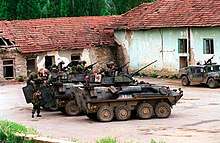
Several detachments in support of MEU operations deploy to support operations in Kismayu and Mogadishu, Somalia from April 1992 through May 1994 during Operation "Restore Hope".[2]
On 20 September 1994 BLT 2/2 landed in Haiti with a LAR platoon attachment during Operation "Restore Democracy". Landing on “Blue Beach” Camp Haitian, the Marines conducted convoy escorts, arms collection, disarmament of the Haitian Forces, and various Humanitarian Effort tasks.[2]
From June to July 1999 an element of D Co deployed with the 26th MEU and participated in Operation "Joint Guardian". As the first U.S. Peacekeepers in Kosovo, the Marines and the Sailors of the MEU provided stability to the embattled region.[2]
During August 1999 elements of D Co deployed with the 26th MEU to support Operation "Avid Response". A Humanitarian mission following an earthquake in Turkey.[2]
On 26 February 2003 the Battalion received a Warning Order to prepare to deploy to Haiti in order to assist in stabilization operations. On 1 March 2003 the first elements of B Co arrived at Port-au-Prince, Haiti.[2]
The company immediately began an aggressive patrol posture combating looters and gangs that controlled the area. They quickly seized control and maintained momentum throughout the deployment.[2]
From 15 January to 8 March 2010, elements of Co B in support of 22 MEU, just returned from a 7-month deployment when they were recalled off of post deployment leave in order to re-deploy to provide humanitarian support to Haiti following the 7.0 magnitude earthquake that struck just west of Port-au-Prince on 12 January 2010. The MEU conducted the re-call and was embarked for departure in less than 56 hours from receiving the order to redeploy for Operation "Unified Response".[2]
Global War on Terror
During late 2001 2d LAR landed at Camp Rhino in Afghanistan which was already held by the 15th MEU to begin the assault on Kandahar. A combined unit formed by 2d and 3d LAR and the 15th and 26th MEU assaulted and took Kandahar international airport in December 2001. Further operations would be held from that location up to February 2002 to include the most notable Operation Anaconda. In February 2002 that base was handed over to 101st Airborne units.
Operation Iraqi Freedom
During early 2003 all three active duty LAR Battalions and the one Reserve Battalion were mobilized and deployed to Kuwait for Operation Iraqi Freedom. LAR Battalions accompanied all the Regimental Combat Teams into action and elements of 1st LAR attached to RCT-5 were among the very first ground combat units into Iraq. Lieutenant General Conway, the MEF Commander, opted to orchestrate the war forward using a pair of LAV-C2s for command and control. LAVs from 2d LAR, attached to Task Force Tarawa, broke through the city of Al Nasiriyah after stiff Fedayeen resistance was encountered. Once in Baghdad, 1st, 2nd, and 3rd LAR Battalions were reorganized into Task Force Tripoli to continue the attack north and capture Saddam Hussein's hometown of Tikrit. Along the way elements of 3d LAR Battalion rescued the American Prisoners of War from the Iraqis. Operation Iraqi Freedom marked the longest inland penetration by US Marine Forces ever, and no units went further and faster than the LAR Battalions, again proving their incredible versatility and capability.
Since Operation Iraqi Freedom began the battalion has completed four 7-month deployments. They participated in the 2003 invasion of Iraq. Delta Co. returned from February to September 2004 and Alpha Co. from September 2004 to March 2005 and then Charlie Co. returned from March to October 2005 to patrol in the southwestern portion of Al Anbar Province. Let it be noted also that during the time in 2005 the formation of Echo Company was created for a brief period of time. For their 3rd deployment, 2nd LAR returned to a split Area of operations in Iraq in September 2006 and remained there until returning to MCB Camp Lejeune in April 2007. Stationed at Camp Korean Village was C. Company along with half of H&S Company. Combat Outpost Rawah had Alpha, Delta, and the other half of H&S Co stationed there. During the last deployment the battalion had four Marines killed in action.[3] The unit is currently stationed in theater in support of Operation Iraqi Freedom.[4]
Significant Events
4-8 February 2003, 2d LAI deployed to Kuwait with Companies A, B, and H&S Company; Weapons Company was disbanded on 17 January and integrated into A and B Companies, C Co was attached to the MEF Headquarters.[2]
On 17 March 2003 at 2345Z the order to move to the dispersal area was received. At 0600Z the battalion began the road march in its standard order; Alpha, Tactical COC, Bravo, Main COC, Combat Train, and the Field Train.[2]
On 19 March 2003 at 0300Z the battalion was ordered to assume MOPP Level 1 due to heightening tensions in the area.[2]
20 March 2003 Saddam Hussein launched his own assault, with a truck bomb exploding at Camp Commando, and missiles fired at Camps Commando, Virginia, New York, and in the vicinity of Highway 80.[2]
At 0300Z on the 21st, Alpha Company led the Battalion through the breach; the Battalion conducted a "Zone Reconnaissance" along Route Tampa and conducted link ups with the Army's TF 3-69 and TF Tarawa and the assault on An Nasiriyah.[2]
After traveling north all day, and battling numerous small enemy detachments the Battalion established a defensive position straddling Highway 7 well north of An Nasiriyah. Almost immediately the Battalion was attacked with both direct and indirect fire weapons systems in a battle that would later be called "The Battle of the Coil".[2]
This battle and the subsequent "Running Gun-fights" through numerous towns would result in the Battalion's renaming as "Destroyers".[2]
On 1 April, reports surfaced that a large number of enemy vehicles, including armor moved into Al Hayy airfield; B Co led the RCT's assault on the airfield. Supported with Cobra's the Regiment attached through Al Hayy which resulted in the destruction of large numbers of enemy vehicles, bunkers, and weapons caches.[2]
After the Battalion fixed the enemy in the vicinity of Al Kut, the Battalion conducted a 250 kilometer road march, bypassing Al Kut. The battalion repositioned itself in the vicinity of An Nu’meniyah.[2]
Following the road march, the Battalion re-designated under TF Tripoli; which consisted of 3 LAR Bns, 5th Bn 11th MarReg, Company G/2/23, and an Engineer Company.[2]
The Destroyer's conducted operations IVO Tikrit until 20 April, following Easter TF Tripoli conducted relief in place with 4th Infantry Div. and the Battalion was ordered to displace back to Tactical Assembly Area (TAA) Paige.[2]
9 through 13 May the battalion moved back to Camp Matilda, Kuwait and began preparing to return home, with the last Marines arriving on 28 June.[2]
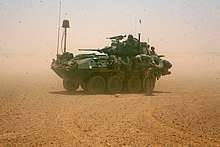
D Company Deployed in support of I MEF on 28 February through September 2004. During the Company's 7-month deployment they conducted several blocking positions, reinforced VCPs, and conducted an aggressive patrolling effort and reconnaissance mission in and around Fallujah and participated in several operations in support of RCT-1.[2]
A Company conducted a relief in place with D Company, 17 Sept 2004. The company conducted combat operations in and around Fallujah from September 2004 to March 2005. During the Company's 7-month deployment they conducted several blocking positions, reinforced VCPs, and conducted an aggressive patrolling effort and reconnaissance mission in and around Fallujah and participated in several operations in support of RCT-1.[2]
From March through October 2005 the Battalion conducted combat operations in the vicinity of Al Asad, Camp Korean Village, and Al Qaim in support of RCT-5.[2]
From 10 September 2006 through April 2007, the Destroyer's found themselves again deployed to Al Anbar, Iraq. This time to Camp Korean Village and AO Rawah. Due to the large number of LAR members that completed several previous deployments to Al Anbar and Camp Korean Village, the terrain was familiar and the battalion was able to rapidly affect changes to the tactical layout of the AO.[2]
The Battalion conducted operations in AO Rawah, Camp Korean Village, Rutbah, Mosul, and Akashat as an independent battalion. The battalion conducted extended desert operations utilizing rapid ground refueling, supported by CH53E. Throughout the deployment, the Battalion supported interdiction operations along the Syrian Border in support of Operation Deny Al-Qaeda North (DAN), a MEF level operation.[2]
Operation Enduring Freedom
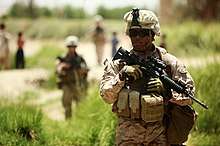
January through April 2002, Co A deploys a platoon in support of BLT 3/6, 26 MEU; They operated in vicinity of Kandahar. During their deployment the detachment conducted VCPs, ECPs, and an aggressive patrolling effort and reconnaissance missions.[2]
March through October 2008, Co B provided a platoon in support of 1/6, 24 MEU. The BLT operated in the southern Helmand Province. At that time they were the southern most coalition force. They established an aggressive patrolling effort and conducted several reconnaissance missions.[2]
May through November 2009, the Battalion conducted operations in the vicinity of Southern Helmand Province. They seized Khan Neshin Castle and established (2) COPS and several Afghan Border Patrol and Afghanistan National Police Stations.[2] The battalion deployed as part of the 2nd Marine Expeditionary Brigade.[5] They were part of the 17,000 troop increase announced by President Obama in mid-February.[6]
Company A deployed in support of 4th LAR from December 2009 through June 2010; conducting operations in the Marjah area.[2]
On 2 July 2009, 2nd LAR, as the southern push of Operation Khanjar, entered Khan Neshin village with the village elders' permission.[7][8][9]
May through November 2011, the Battalion deployed again to the vicinity of Southern Helmand Province with headquarters elements operating out of FOB Payne with numerous COPS and patrol bases spread throughout the area.
Awards
The battalion has been awarded the following battle streamers:
See also
Notes
- "LAV History". Marine Corps Training and Education Command. USMC. Retrieved 22 May 2010.
- "2nd Light Armored Reconnaissance History". US Marine Corps. Retrieved 8 June 2018.

- Friel, Lucian. "'Destroyers' mark end of 3rd OIF deployment". Marine Corps News. USMC. Archived from the original on 10 April 2007. Retrieved 3 April 2007.
- 2nd LAR embarks to Anbar province of Iraq 5th Time
- Hlad, Jennifer (9 March 2008). "2/8, other Lejeune units to deploy with 2nd MEB". www.enctoday.com. Archived from the original on 14 March 2009. Retrieved 9 March 2009.
- Page, Susan (16 February 2009). "Obama OKs adding Afghanistan forces". USA Today. Retrieved 23 April 2010.
- Shanker, Thom; Oppel Jr., Richard A. (3 July 2009). "In Tactical Shift, Troops Will Stay and Hold Ground in Afghanistan". NY Times. Retrieved 6 July 2009.
- Sheppard, Ben (3 July 2009). "US Marines battle on in Afghanistan". Sydney Morning Herald. Retrieved 4 July 2009.
- "Operation Khanjar restores government control in Khan Neshin". ABC. 6 July 2009. Archived from the original on 9 July 2009. Retrieved 6 July 2009.
References

External links
| Wikimedia Commons has media related to 2nd Light Armored Reconnaissance Battalion (United States). |
